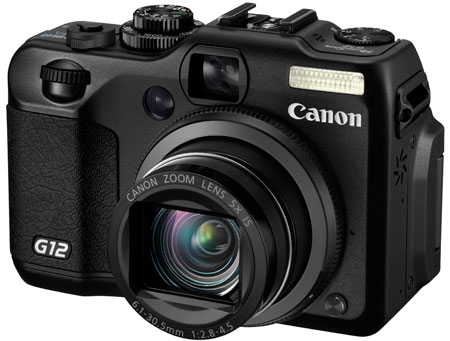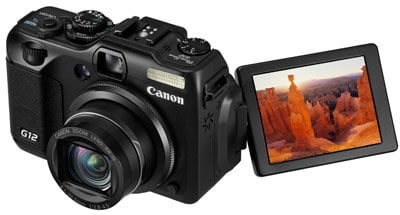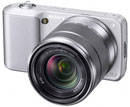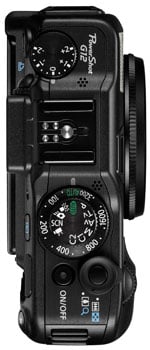Canon PowerShot G12
-
-
Written by Gordon Laing
Verdict
Canon’s PowerShot G12 continues the G-series’ proud tradition of delivering high-end features and full manual control in a chunky but portable body. This is Canon’s flagship compact: a well-built and feature-packed camera designed to appeal to enthusiasts.
The core specification hasn’t changed since the G11, but a selection of minor upgrades address some of the issues facing the earlier model, while others take inspiration from the best of the competition, most notably its major rival from Panasonic.
So with the PowerShot G12 you’re still getting a sensible 10 Megapixel sensor, 5x zoom, fully articulated 2.8in screen, full manual control, flash hotshoe, RAW recording, and a retro-styled body that’s packed with physical controls. To this, the new model adds 720p HD video with stereo sound, in-camera HDR, Hybrid Image Stabilisation, Dynamic Range enhancement, Tracking AF, new special effects, a choice of aspect ratios, an electronic levelling guide, finger control dial, finer ISO increments, and support for an optional filter adapter. As we said at the start of this review, there’s no major changes here, but by adding a broad selection of minor ones, Canon’s flagship compact has become more sophisticated, powerful and easier to control.
 |
Canon may have branded the G12 as an ‘HS’ High Sensitivity model, but there’s no surprises with the image quality which with the same lens, sensor and image processor remains the same as the G11 before it. The results are crisp and detailed at the lowest sensitivities, while the use of a slightly larger sensor than average compacts means you’ll enjoy fair results at 400 ISO, or even 800 at a push, depending on your expectations. You can see a full report in our PowerShot G12 High ISO Noise results page.
The new 720p HD movie mode was an essential upgrade for this camera, and brings the G12 in-line with the video capabilities of most 2010 compacts. Annoyingly you still can’t optically zoom while filming, but the quality remains pretty good, and as you’ll see in our sample clips, the slightly larger sensor minimises highlight clipping (with subsequent vertical streaks) which plague many CCD based compacts.
 |
The new electronic level may only operate in a single axis, but is a nice addition to a compact. Another unexpected but welcome update is finding the earlier i-Contrast function expanded into separate highlight and shadow protection settings, which as you can see on our first page, can make a big difference in challenging conditions. The new in-camera HDR mode may require a tripod (and operate with automatic ISO) and is nowhere near as powerful as creating them manually, but offers a quick fix which can be effective at boosting shadow areas.
Several of the G12’s new features feel like a direct response to the rival Panasonic LX model. As such, the G12 now sports AF tracking, which works like the LX5, along with a broader choice of aspect ratios. The latter don’t work so well on the G12 though as unlike the LX5, they simply involve cropping and therefore offer nothing you can’t do in software later.
Canon may have also accelerated the continuous shooting speed, and unlike the LX5, the G12 can keep shooting full sized JPEGs until it runs out of memory. But, and the big but, is that the speed is only 2fps. That may be twice as fast as the G11, but remains far too slow to be useful for action photography. If you’re desperate for quicker frame rates you could set the G12 to Low Light mode, but you’ll have to accept a drop in resolution to 2.5 Megapixels. Fitting the G12 with a CMOS sensor could have delivered much quicker burst rates, not to mention 1080 video capabilities, so it’ll be interesting if this is the future direction for this product – although as seen on Panasonic’s Lumix FZ100, fitting a CMOS sensor could have a detrimental effect on still photo quality.
Where the G12 continues to delight though is with its physical handling and degree of manual control. Its predecessor was hardly lacking in this respect with no fewer than three dials on the upper surface alone, but Canon’s now added a front finger dial along with refining the dedicated ISO dial to offer increments of 1/3EV. When you include the rear thumb wheel, customisable shortcut key and additional dedicated buttons, there’s few day-to-day settings on the G12 which can’t be physically adjusted in an instant. It all adds up to a very tactile and satisfying experience.
Throw-in the other core features of its predecessor, including the flash hotshoe, optical viewfinder and fully articulated screen, and you’ve got a very powerful and flexible compact camera. The only flies in the ointment are the increasing numbers of compacts sporting considerably larger sensors and the flexibility of interchangeable lenses. These ‘EVIL’ models represent a major rival for any compact aimed at enthusiasts, and while they’re currently all more expensive, many enthusiasts are willing to pay for their improved image quality. So before wrapping-up, how does the PowerShot G12 compare against some key rivals?
Compared to Panasonic Lumix DMC-LX5
 | ||
Panasonic’s Lumix DMC-LX5 is arguably the closest rival to the PowerShot G12. Both cameras offer manual control, flash hotshoes, RAW recording, high resolution screens and wide angle coverage in relatively pocketable form factors, along with the same 10 Megapixel resolution to better-manage noise. Despite these similarities though, there remain a number of key differences between them.
In its favour, the LX5’s lens has wider-angle coverage equivalent to an impressive 24mm, while additionally boasting a brighter focal ratio of f2.0-3.3. There’s full manual control over movies and you can zoom the lens while filming. Unlike the G12 which simply crops its images to deliver different aspect ratios, the LX5 maintains its angle of view. In our tests, the LX5 was a snappier focuser, and the camera itself is comfortably smaller, around one third lighter and around 15% cheaper at the time of writing. Panasonic also offers an optional electronic viewfinder accessory.
It’s far from a one-sided argument though. Most obviously the PowerShot G12 may not zoom as wide as the LX5, but does reach further to an equivalent of 140mm compared to 90mm on the Panasonic. Both cameras may sport 460k screens, but the G12’s is fully-articulated. The G12 also features a built-in optical viewfinder, which can greatly extend the battery life, or eek-out a few extra shots when the power’s running low. It also features in-camera HDR, built-in ND filter and an electronic levelling guide, while the use of a built-in lens cap makes it quicker to start-up and pack away.
As before it’s a case of swings and roundabouts, with the choice boiling down to which feature-set and zoom range best suits your requirements, along with which model looks and feels best to you in person. Either way, the LX5 is sure to tempt, especially given its lower price. See our Panasonic Lumix DMC-LX5 review for more details.
Compared to Canon PowerShot S95
 | ||
Canon’s PowerShot S95 is another model to consider as it shares a great deal in common with the G12. Both cameras share full manual control, support for RAW files, screens with 460k resolution, HDMI ports and the same sensor with support for 720p HD movies and stereo sound. Beyond these initial similarities though, both cameras represent quite different propositions.
In its favour the G12 has a fully-articulated (albeit slightly smaller 2.8in) screen which can flip and twist to any angle, along with an optical viewfinder which is handy in direct sunlight or for squeezing a few extra shots out of a failing battery. Both lenses start at an equivalent of 28mm, but the G12’s zooms almost 40% longer to 140mm, allowing it to better grab distant details.
There’s a hotshoe for mounting proper Speedlite flashguns, dedicated dials for the ISO and exposure compensation, an electronic levelling guide, a built-in ND filter, an adjustable single area AF mode, an official filter mount accessory, and while the body is considerably larger and heavier, it lends it a greater air of confidence, while additionally giving you more to hold onto and a longer battery life.
In its favour, the S95 is considerably smaller and less than half the weight, while featuring a lens with a brighter f2.0 focal ratio when zoomed-out, a slightly larger 3in screen and a neat customisable lens ring control. Indeed while the S95 lacks many of the G12’s dedicated buttons and dials, you can still achieve a great deal of control by using its thumb wheel and customising the lens ring and shortcut key.
The S95 essentially packs the quality and control of the G12 into a much smaller and lighter package with a brighter lens, and as such arguably becomes a more compelling camera for anyone looking for a powerful and truly pocketable compact. If you can live without the articulated screen, flash hotshoe, and optical viewfinder, the S95 could be a better choice. Think of it as the Digital IXUS / ELPH for demanding photographers. See our Canon PowerShot S95 review for more details.
Compared to Sony Alpha NEX-3
 | ||
There are a number of compacts featuring DSLR-sized sensors and removeable lenses on the market today, but for comparison here we’ve chosen the Sony Alpha NEX-3 as one of the most compelling alternatives to the PowerShot G12 at the time of writing.
In its favour, the NEX-3 features a considerably bigger sensor, indeed one that’s the same size as in most DSLRs. This means much lower noise at higher sensitivities, higher dynamic range and the potential for shallower depth-of-field effects – it also has 40% more pixels in total. The NEX-3 also features a removeable lens mount, and while it doesn’t have a 28-140mm zoom, there’s simply the potential for many more lens options. Both the NEX-3 and PowerShot G12 feature articulated screens, but the Sony’s is larger and more detailed, albeit only tilting in one axis. The NEX-3 additionally boasts a number of innovative options which combine multiple exposures in-camera to reduce noise, minimise motion blur or even generate panoramas, including 3D options. The continuous shooting is also quick at up to 7fps, and if you opt for the pricier NEX-5 version, you’ll enjoy 1080p movies. And while neither NEX has a flash hotshoe, Sony has previewed an optional flashgun, not to mention a high quality stereo microphone.
In its favour, the PowerShot G12 features a built-in 5x (28-140mm) zoom and few if any concerns over dust getting onto the sensor; its larger inherent depth-of-field will also minimise focusing errors on general snaps. The G12 additionally features a flash hotshoe, electronic levelling guide and a screen that can flip or twist to any angle, while enthusiasts will also prefer the wealth of physical controls on the G12. Finally, the G12 costs approximately one quarter less than the NEX-3, and unlike all the EVIL (and DSLR) cameras to date, it can also fire its shutter in virtual silence.
Ultimately the PowerShot G12 may be smaller and lighter than the NEX-3 and other EVIL compacts, at least when they’re fitted with zoom lenses, but it’s no longer significantly more pocketable than a camera with a DSLR-sized sensor. If you’re willing to increase your budget and carry a camera that’s only a little bigger and heavier, you can enjoy a much larger sensor and removeable lenses, not to mention the other benefits listed above. It’s a compelling proposition for enthusiasts.
For more details see our Sony Alpha NEX-3 / 5 review.
Canon PowerShot G12 final verdict
Canon’s PowerShot G12 may only represent a modest update over its predecessor, but by addressing some of the criticisms of that model while adding a few small but neat new features, it’s become a preferable camera overall. So the first headline is Canon’s flagship compact has just got even better.
 |
Unfortunately for the G12 though, the market for enthusiast-level compacts is changing quickly, and Canon’s top dog is looking increasingly uncomfortable. Panasonic’s Lumix LX5 may not sport an articulated screen or optical viewfinder, but by packing a wider and brighter lens, with snappier focusing and manual control over movies into a smaller, lighter and cheaper package, it’ll be preferred by many enthusiasts. If however you’re after a truly pocketable compact which still offers a decent degree of control, then Canon’s own PowerShot S95 is much more compelling.
The biggest problem for the PowerShot G12 though is the availability of cameras sporting DSLR sized sensors and removeable lens mounts, that are roughly the same size and weight. Almost unbelievably, models like Sony’s Alpha NEX-5 are actually smaller and lighter than the G12, at least when fitted with a fixed prime lens. To be fair, these so-called ‘EVIL’ compacts become bigger and heavier when fitted with zoom lenses, and they’re also more expensive than the PowerShot G12, but many enthusiasts would be more than happy to make these sacrifices to enjoy their quality and flexibility.
Previously a DSLR-sized sensor demanded a DSLR-sized body, so a model like the G12 was an ideal carry-everywhere companion for enthusiasts. But now the space and weight saving over an EVIL alternative is minimal.
Interestingly in today’s market, Canon’s PowerShot S95 feels the most relevant in its peer group. It may not ultimately offer the same degree of control and features as the G12, nor Panasonic’s LX5, but with smaller dimensions, it crucially delivers a more portable proposition to models with bigger sensors. In contrast the G12, despite sporting a wonderful array of manual controls, is just physically too close to models which pack-in DSLR sensors, and that’s difficult for enthusiasts to ignore.
That said, the PowerShot G12 remains a delight to use, and if you’re happy with its relative heft, lens range and high ISO performance, then there’s a lot to like. Certainly if you’re into physical controls, you’ll be in dial-heaven. Ultimately we can recommend the G12 to enthusiasts who fully understand the other options available, but like the Lumix LX5, it misses out on our top rating in an increasing market of alternatives with big sensors. As the market for EVIL cameras steadily grows, we wonder how many more generations of the G-series we can expect – at least those equipped with small sensors anyway.
|
Good points 5x zoom with 28mm wide and 1cm macro. Flash hotshoe, RAW files and full manual controls. Great quality 2.8in / 460k articulated screen. Superb controls, build and ergonomics. Bad points 
| Scores (relative to 2010 enthusiast (non-EVIL) compacts) | |||
Build quality: Image quality: Handling: Specification: Value: Overall:
|
18 / 20 18 / 20 18 / 20 18 / 20 15 / 20 87% | |||




